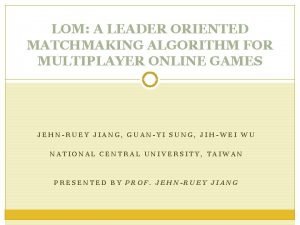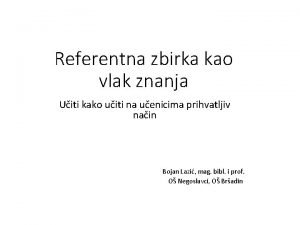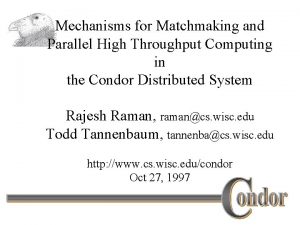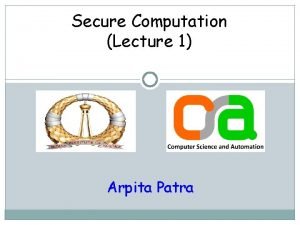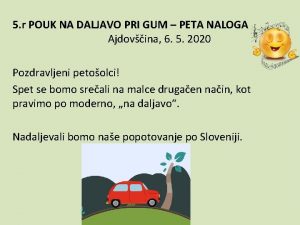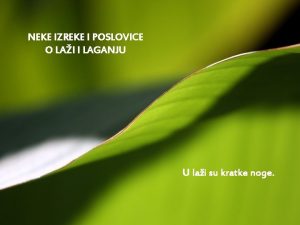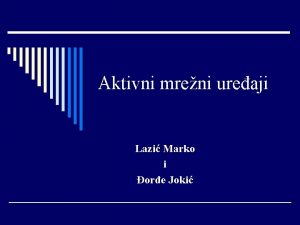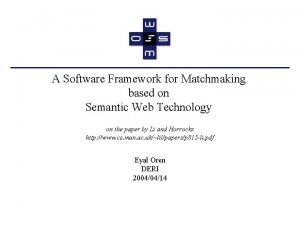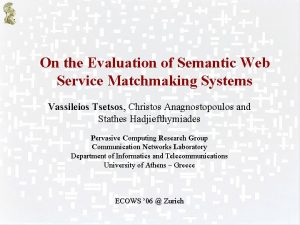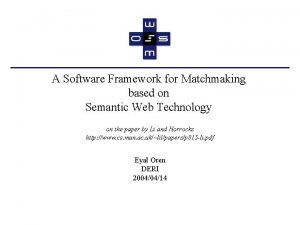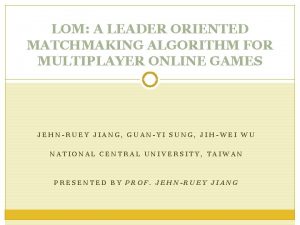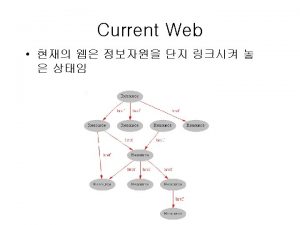SEMANTIC MATCHMAKING ALGORITHM Marko Lazi 33352011 marko lazic








![9 /10 References • [1] JENA: Java Framework for Building Semantic Web Applications. • 9 /10 References • [1] JENA: Java Framework for Building Semantic Web Applications. •](https://slidetodoc.com/presentation_image/5ce5164dd148645c0d65b71e28d77c25/image-9.jpg)

- Slides: 10

SEMANTIC MATCHMAKING ALGORITHM Marko Lazić 3335/2011 marko. lazic 88@gmail. com Department of Computer Engineering and Computer Science, School of Electrical Engineering, University of Belgrade

2/10 Introduction • The ability to dynamically discover and invoke a Web Service is a critical aspect of Service Oriented Architectures • In order to overcome the limitations of a syntax-based search, matchmaking algorithms • originally proposed by M. Paolucci

3 /10 Algorithm • The algorithm takes a OWL-S Query from the client as input • Iterates over every OWL-S Advertisement in its repository in order to determine a match • An Advertisement and a Query match if their Outputs and Inputs match • The algorithm returns a set of matching advertisements sorted according to the degree of match

4/10 Algorithm(2) • Let Queryout and Advtout represent the list of output concepts of the Query and Advertisement respectively • Matching the outputs requires the matching between two concept-lists, Queryout and Advtout

5 /10 Algorithm(3) • Let Queryin and Advtin represent the list of input Concepts of the Query and Advertisement respectively. • Matching the inputs requires:

6 /10 Degrees of match (1) • Four degrees of match are defined between a them: • Exact: • If out. A is an equivalent concept to out. Q or out. A is a superclass of out. Q • In case of a superclass relationship, it is assumed that the service provider has agreed to support every possible subclass of out. A • Plugin: • If out. A Subsumes out. Q • The relation between out. A and out. R is weaker as compared to the previous case since subsumption is indirectly inferred by the reasoner • It is assumed that the provider has agreed to support some subconcepts of out. A • We hence infer that out. A can be plugged in place of the required out. R

7 /10 Degrees of match (2) • Subsume • If out. Q Subsumes out. A • The set of individuals defined by the concept, out. A, is a subset of the set of individuals defined by the concept out. R • Fail: If none of the above conditions are satisfied

8 /10 Conclusion • outcome of the matchmaker depends on the order of the concepts in the Query • Semantic matchmaking should be agnostic of the syntactic ordering of the concepts in the Advertisements and Queries • instead of the greedy approach adopted by this algorithm there could be made better approach
![9 10 References 1 JENA Java Framework for Building Semantic Web Applications 9 /10 References • [1] JENA: Java Framework for Building Semantic Web Applications. •](https://slidetodoc.com/presentation_image/5ce5164dd148645c0d65b71e28d77c25/image-9.jpg)
9 /10 References • [1] JENA: Java Framework for Building Semantic Web Applications. • • http: //jena. sourceforge. net/. [2] MINDSWAP: Maryland Information and Network Dynamics Lab Semantic Web Agents Project, OWL-S API. http: //www. mindswap. org/2004/owl-s/api/. [3] North American Industry Classification System. http: //www. naics. com/. [4] OWL-S Service Retrieval Test Collection. Version 2. 1. http: //projects. semwebcentral. org/projects/owls-tc/. [5] Pellet: An OWL DL Reasoner. http: //pellet. owldl. com/. [6] Protege: Ontology Editor and Knowledge-base framework. http: //protege. stanford. edu/. [7] Racer. Pro: OWL Reasoner and Inference Server for the Semantic Web. http: //www. racer-systems. com/. [8] Universal Description Discovery and Integration (UDDI). http: //uddi. org/.

10 /10 QUESTIONS? Marko Lazić(marko. lazic 88@gmail. com) Department of Computer Engineering and Computer Science, School of Electrical Engineering, University of Belgrade
